
New Top 10 Audio Normalizers for Windows-Dont Miss It

Top 10 Audio Normalizers for Windows-Don’t Miss It
An audio normalizer is a tool that helps to change the overall volume of audio by a set amount to reach a predetermined level. In simple words, it can be defined as turning up the volume of an audio file without losing the audio quality.
Sound normalization is done for mainly two reasons. One is to increase the volume of a quiet audio file without making changes in its dynamic range for easy and better hearing. The other reason is to achieve matching volumes for different audio files.
While the sound of the audio gets increased during audio normalization, the noise will also get increased. So make sure that normalization is done properly within the right limit.
Top 10 Audio Normalizers for Windows
Audio normalization was commonly done in the early days when digital audio was enjoyed. The performance of many audio components was limited in signal-to-noise ratio and dynamic range, and sound normalization helped.
Normalization is still a useful feature that helps to equalize volume in different files. Let us look at some of the best audio normalizers available in Windows.
1. Wondershare Filmora
For Win 7 or later (64-bit)
For macOS 10.12 or later
Wondershare Filmora is a widely used video editing application famous for its extensive video and audio editing features. The Auto Normalization in Filmora is an AI integrated feature that analyses the volume of all the clips you have selected. It then automatically adjusts the volumes to 23.0LUFS, the standard loudness level of European audio programs.
To enable Auto Normalization on Filmora:
Go to the timeline and double click on the audio clip you wish to normalize, and from the window that appears, go to Audio, select Audio Normalization, and tap OK.
The audio will be analyzed and normalized automatically within some time.
2. Audacity
Audacity is a free and open-sourced audio software used on all operating systems. Its simple interface and compatibility across different platforms are the main reasons for its popularity.
The sound normalization feature of audacity can be used to set the peak amplitude of any track. It also allows to equalize the balance of the right and left channels of any stereo tracks.
Open audacity, click on Effect from the top toolbar, and then select Normalize. Three different options will be given for you to apply.
You can remove the DC offset, independently normalize stereo channels or normalize the maximum amplitude to your desired decibel.
3. Adobe Premiere Pro
As you all might know Adobe premium pro is a wonderful video editing application used by beginners and professionals alike. To normalize audio on adobe premium pro, go to the timeline, right-click on the audio file, and tap on Audio Gain…
A small window will appear, from which you can select the Normalize Max Peak to: option. The dB can be manually adjusted to your desired limit.
Click OK after making the necessary adjustments, and the changes will take place instantly.
4. MP3Gain
MP3Gain is an audio normalizing tool that analyses and adjusts the volumes of mp3 files so that they all have the same volume. They also ensure the original quality after the sound normalization process.
After the installation of MP3 gain on your device open it. Select Options, then Filename Display, and then Show File Only. Then tap on Add File(s) and add the files you need to normalize to MP3Gain.
This application can be used to play several songs at the same volume and the need to adjust the volume at the beginning of each song can be avoided.
5. VLC Video Player
Even though you might be familiar with VLC as a video player, it has many features that help to make changes in the audio and video of a file.
The player has a built-in sound normalization feature that can be enabled when needed. Open the player and tap on Tools from the top toolbar and then on the Preferences option. Choose to show All settings from the bottom right and select Filters under the Audio from the left panel. Tick mark the Volume normalizer option and hit the Save button.
The volume level can also be adjusted from the Volume normalizer panel under the Filters option.
6. Final Cut Pro
Final cut pro x is a non-linear and nondestructive video application commonly used on Apple devices. This application offers improved rendering, playback, and transcoding.
To normalize audio on final cut pro x, open the application and tap on the Modify option, then on Audio, and finally on Apply Normalization Gain.
To normalize more than one audio clip make sure that the audio level of each clip is set to 0 dB. This can be done by tapping on Edit and then on Remove Attributes. So for better results, make sure that the audio level of each clip is set to 0dB before normalization.
7. Handbrake
Handbrake is an open-source video transcoder that can convert any video format to any desired codecs. It also has some video and audio editing features. The sound normalization feature in Handbrake allows the user to adjust the dynamic range of some of the audio formats.
To increase the audio gain on Handbrake, select Source on the app and make sure the video file and destination are correct. Then click on the Audio option and adjust the Gain.
8. Reaper
Reaper is an all-in-one audio production application that offers extensive audio editing features, including MIDI recording, editing, mixing, processing, etc. To bring the volume level to a higher level using an audio normalizer in Reaper, open the application and import the audio files.
Reaper offers keyboard shortcuts for applying different features and normalizing audio on PC. The shortcut is Control + Shift + N.
This app also allows manual normalization using a knob which can be done according to the user preference.
9. AIMP
AIMP is a freeware audio player used by many android and windows users to enjoy music. This player offers an audio normalization feature that can be applied to all the files by default.
To do so, go to DSP manager in AIMP and click on the Volume normalization tab. Mark the Normalize volume option and make changes to the settings.
You can adjust the target volume level, the upper threshold of the preamp, and the lower threshold of preamp in the settings. The app also allows making changes to the gain values.
10. Movavi
Movavi is a video editor with a very intuitive interface and a big collection of effects. Normalizing the audio using Movavi is very simple, and to do so, open the application and import the file first to the timeline.
Double click on the file on the timeline and click on Clip Properties. From the General tab, tick mark the Normalize box, and the whole audio track will be normalized.
What is the best audio normalizer for you?
An audio normalizer can be used for a variety of purposes. Some people use it to play songs without having to adjust the volume for each song manually, others use it for enhancing the volume of songs that has a very low volume, and some others use it for video editing purposes.
A list of applications with sound normalizers has been listed above, and you can choose any one of them depending on your purpose. Some of these apps, like Wondershare Filmora, Final Cut Pro X offers extensive audio editing features and audio normalization, which can be very helpful in video editing. If you wish to increase the volume of the files while playing, you can go with VLC, MP3Gain, etc. Hope our suggestion helps to provide you with a better audio experience.
Versatile Video Editor - Wondershare Filmora
An easy yet powerful editor
Numerous effects to choose from
Detailed tutorials provided by the official channel
For Win 7 or later (64-bit)
For macOS 10.12 or later
Wondershare Filmora is a widely used video editing application famous for its extensive video and audio editing features. The Auto Normalization in Filmora is an AI integrated feature that analyses the volume of all the clips you have selected. It then automatically adjusts the volumes to 23.0LUFS, the standard loudness level of European audio programs.
To enable Auto Normalization on Filmora:
Go to the timeline and double click on the audio clip you wish to normalize, and from the window that appears, go to Audio, select Audio Normalization, and tap OK.
The audio will be analyzed and normalized automatically within some time.
2. Audacity
Audacity is a free and open-sourced audio software used on all operating systems. Its simple interface and compatibility across different platforms are the main reasons for its popularity.
The sound normalization feature of audacity can be used to set the peak amplitude of any track. It also allows to equalize the balance of the right and left channels of any stereo tracks.
Open audacity, click on Effect from the top toolbar, and then select Normalize. Three different options will be given for you to apply.
You can remove the DC offset, independently normalize stereo channels or normalize the maximum amplitude to your desired decibel.
3. Adobe Premiere Pro
As you all might know Adobe premium pro is a wonderful video editing application used by beginners and professionals alike. To normalize audio on adobe premium pro, go to the timeline, right-click on the audio file, and tap on Audio Gain…
A small window will appear, from which you can select the Normalize Max Peak to: option. The dB can be manually adjusted to your desired limit.
Click OK after making the necessary adjustments, and the changes will take place instantly.
4. MP3Gain
MP3Gain is an audio normalizing tool that analyses and adjusts the volumes of mp3 files so that they all have the same volume. They also ensure the original quality after the sound normalization process.
After the installation of MP3 gain on your device open it. Select Options, then Filename Display, and then Show File Only. Then tap on Add File(s) and add the files you need to normalize to MP3Gain.
This application can be used to play several songs at the same volume and the need to adjust the volume at the beginning of each song can be avoided.
5. VLC Video Player
Even though you might be familiar with VLC as a video player, it has many features that help to make changes in the audio and video of a file.
The player has a built-in sound normalization feature that can be enabled when needed. Open the player and tap on Tools from the top toolbar and then on the Preferences option. Choose to show All settings from the bottom right and select Filters under the Audio from the left panel. Tick mark the Volume normalizer option and hit the Save button.
The volume level can also be adjusted from the Volume normalizer panel under the Filters option.
6. Final Cut Pro
Final cut pro x is a non-linear and nondestructive video application commonly used on Apple devices. This application offers improved rendering, playback, and transcoding.
To normalize audio on final cut pro x, open the application and tap on the Modify option, then on Audio, and finally on Apply Normalization Gain.
To normalize more than one audio clip make sure that the audio level of each clip is set to 0 dB. This can be done by tapping on Edit and then on Remove Attributes. So for better results, make sure that the audio level of each clip is set to 0dB before normalization.
7. Handbrake
Handbrake is an open-source video transcoder that can convert any video format to any desired codecs. It also has some video and audio editing features. The sound normalization feature in Handbrake allows the user to adjust the dynamic range of some of the audio formats.
To increase the audio gain on Handbrake, select Source on the app and make sure the video file and destination are correct. Then click on the Audio option and adjust the Gain.
8. Reaper
Reaper is an all-in-one audio production application that offers extensive audio editing features, including MIDI recording, editing, mixing, processing, etc. To bring the volume level to a higher level using an audio normalizer in Reaper, open the application and import the audio files.
Reaper offers keyboard shortcuts for applying different features and normalizing audio on PC. The shortcut is Control + Shift + N.
This app also allows manual normalization using a knob which can be done according to the user preference.
9. AIMP
AIMP is a freeware audio player used by many android and windows users to enjoy music. This player offers an audio normalization feature that can be applied to all the files by default.
To do so, go to DSP manager in AIMP and click on the Volume normalization tab. Mark the Normalize volume option and make changes to the settings.
You can adjust the target volume level, the upper threshold of the preamp, and the lower threshold of preamp in the settings. The app also allows making changes to the gain values.
10. Movavi
Movavi is a video editor with a very intuitive interface and a big collection of effects. Normalizing the audio using Movavi is very simple, and to do so, open the application and import the file first to the timeline.
Double click on the file on the timeline and click on Clip Properties. From the General tab, tick mark the Normalize box, and the whole audio track will be normalized.
What is the best audio normalizer for you?
An audio normalizer can be used for a variety of purposes. Some people use it to play songs without having to adjust the volume for each song manually, others use it for enhancing the volume of songs that has a very low volume, and some others use it for video editing purposes.
A list of applications with sound normalizers has been listed above, and you can choose any one of them depending on your purpose. Some of these apps, like Wondershare Filmora, Final Cut Pro X offers extensive audio editing features and audio normalization, which can be very helpful in video editing. If you wish to increase the volume of the files while playing, you can go with VLC, MP3Gain, etc. Hope our suggestion helps to provide you with a better audio experience.
Versatile Video Editor - Wondershare Filmora
An easy yet powerful editor
Numerous effects to choose from
Detailed tutorials provided by the official channel
For Win 7 or later (64-bit)
For macOS 10.12 or later
Wondershare Filmora is a widely used video editing application famous for its extensive video and audio editing features. The Auto Normalization in Filmora is an AI integrated feature that analyses the volume of all the clips you have selected. It then automatically adjusts the volumes to 23.0LUFS, the standard loudness level of European audio programs.
To enable Auto Normalization on Filmora:
Go to the timeline and double click on the audio clip you wish to normalize, and from the window that appears, go to Audio, select Audio Normalization, and tap OK.
The audio will be analyzed and normalized automatically within some time.
2. Audacity
Audacity is a free and open-sourced audio software used on all operating systems. Its simple interface and compatibility across different platforms are the main reasons for its popularity.
The sound normalization feature of audacity can be used to set the peak amplitude of any track. It also allows to equalize the balance of the right and left channels of any stereo tracks.
Open audacity, click on Effect from the top toolbar, and then select Normalize. Three different options will be given for you to apply.
You can remove the DC offset, independently normalize stereo channels or normalize the maximum amplitude to your desired decibel.
3. Adobe Premiere Pro
As you all might know Adobe premium pro is a wonderful video editing application used by beginners and professionals alike. To normalize audio on adobe premium pro, go to the timeline, right-click on the audio file, and tap on Audio Gain…
A small window will appear, from which you can select the Normalize Max Peak to: option. The dB can be manually adjusted to your desired limit.
Click OK after making the necessary adjustments, and the changes will take place instantly.
4. MP3Gain
MP3Gain is an audio normalizing tool that analyses and adjusts the volumes of mp3 files so that they all have the same volume. They also ensure the original quality after the sound normalization process.
After the installation of MP3 gain on your device open it. Select Options, then Filename Display, and then Show File Only. Then tap on Add File(s) and add the files you need to normalize to MP3Gain.
This application can be used to play several songs at the same volume and the need to adjust the volume at the beginning of each song can be avoided.
5. VLC Video Player
Even though you might be familiar with VLC as a video player, it has many features that help to make changes in the audio and video of a file.
The player has a built-in sound normalization feature that can be enabled when needed. Open the player and tap on Tools from the top toolbar and then on the Preferences option. Choose to show All settings from the bottom right and select Filters under the Audio from the left panel. Tick mark the Volume normalizer option and hit the Save button.
The volume level can also be adjusted from the Volume normalizer panel under the Filters option.
6. Final Cut Pro
Final cut pro x is a non-linear and nondestructive video application commonly used on Apple devices. This application offers improved rendering, playback, and transcoding.
To normalize audio on final cut pro x, open the application and tap on the Modify option, then on Audio, and finally on Apply Normalization Gain.
To normalize more than one audio clip make sure that the audio level of each clip is set to 0 dB. This can be done by tapping on Edit and then on Remove Attributes. So for better results, make sure that the audio level of each clip is set to 0dB before normalization.
7. Handbrake
Handbrake is an open-source video transcoder that can convert any video format to any desired codecs. It also has some video and audio editing features. The sound normalization feature in Handbrake allows the user to adjust the dynamic range of some of the audio formats.
To increase the audio gain on Handbrake, select Source on the app and make sure the video file and destination are correct. Then click on the Audio option and adjust the Gain.
8. Reaper
Reaper is an all-in-one audio production application that offers extensive audio editing features, including MIDI recording, editing, mixing, processing, etc. To bring the volume level to a higher level using an audio normalizer in Reaper, open the application and import the audio files.
Reaper offers keyboard shortcuts for applying different features and normalizing audio on PC. The shortcut is Control + Shift + N.
This app also allows manual normalization using a knob which can be done according to the user preference.
9. AIMP
AIMP is a freeware audio player used by many android and windows users to enjoy music. This player offers an audio normalization feature that can be applied to all the files by default.
To do so, go to DSP manager in AIMP and click on the Volume normalization tab. Mark the Normalize volume option and make changes to the settings.
You can adjust the target volume level, the upper threshold of the preamp, and the lower threshold of preamp in the settings. The app also allows making changes to the gain values.
10. Movavi
Movavi is a video editor with a very intuitive interface and a big collection of effects. Normalizing the audio using Movavi is very simple, and to do so, open the application and import the file first to the timeline.
Double click on the file on the timeline and click on Clip Properties. From the General tab, tick mark the Normalize box, and the whole audio track will be normalized.
What is the best audio normalizer for you?
An audio normalizer can be used for a variety of purposes. Some people use it to play songs without having to adjust the volume for each song manually, others use it for enhancing the volume of songs that has a very low volume, and some others use it for video editing purposes.
A list of applications with sound normalizers has been listed above, and you can choose any one of them depending on your purpose. Some of these apps, like Wondershare Filmora, Final Cut Pro X offers extensive audio editing features and audio normalization, which can be very helpful in video editing. If you wish to increase the volume of the files while playing, you can go with VLC, MP3Gain, etc. Hope our suggestion helps to provide you with a better audio experience.
Versatile Video Editor - Wondershare Filmora
An easy yet powerful editor
Numerous effects to choose from
Detailed tutorials provided by the official channel
For Win 7 or later (64-bit)
For macOS 10.12 or later
Wondershare Filmora is a widely used video editing application famous for its extensive video and audio editing features. The Auto Normalization in Filmora is an AI integrated feature that analyses the volume of all the clips you have selected. It then automatically adjusts the volumes to 23.0LUFS, the standard loudness level of European audio programs.
To enable Auto Normalization on Filmora:
Go to the timeline and double click on the audio clip you wish to normalize, and from the window that appears, go to Audio, select Audio Normalization, and tap OK.
The audio will be analyzed and normalized automatically within some time.
2. Audacity
Audacity is a free and open-sourced audio software used on all operating systems. Its simple interface and compatibility across different platforms are the main reasons for its popularity.
The sound normalization feature of audacity can be used to set the peak amplitude of any track. It also allows to equalize the balance of the right and left channels of any stereo tracks.
Open audacity, click on Effect from the top toolbar, and then select Normalize. Three different options will be given for you to apply.
You can remove the DC offset, independently normalize stereo channels or normalize the maximum amplitude to your desired decibel.
3. Adobe Premiere Pro
As you all might know Adobe premium pro is a wonderful video editing application used by beginners and professionals alike. To normalize audio on adobe premium pro, go to the timeline, right-click on the audio file, and tap on Audio Gain…
A small window will appear, from which you can select the Normalize Max Peak to: option. The dB can be manually adjusted to your desired limit.
Click OK after making the necessary adjustments, and the changes will take place instantly.
4. MP3Gain
MP3Gain is an audio normalizing tool that analyses and adjusts the volumes of mp3 files so that they all have the same volume. They also ensure the original quality after the sound normalization process.
After the installation of MP3 gain on your device open it. Select Options, then Filename Display, and then Show File Only. Then tap on Add File(s) and add the files you need to normalize to MP3Gain.
This application can be used to play several songs at the same volume and the need to adjust the volume at the beginning of each song can be avoided.
5. VLC Video Player
Even though you might be familiar with VLC as a video player, it has many features that help to make changes in the audio and video of a file.
The player has a built-in sound normalization feature that can be enabled when needed. Open the player and tap on Tools from the top toolbar and then on the Preferences option. Choose to show All settings from the bottom right and select Filters under the Audio from the left panel. Tick mark the Volume normalizer option and hit the Save button.
The volume level can also be adjusted from the Volume normalizer panel under the Filters option.
6. Final Cut Pro
Final cut pro x is a non-linear and nondestructive video application commonly used on Apple devices. This application offers improved rendering, playback, and transcoding.
To normalize audio on final cut pro x, open the application and tap on the Modify option, then on Audio, and finally on Apply Normalization Gain.
To normalize more than one audio clip make sure that the audio level of each clip is set to 0 dB. This can be done by tapping on Edit and then on Remove Attributes. So for better results, make sure that the audio level of each clip is set to 0dB before normalization.
7. Handbrake
Handbrake is an open-source video transcoder that can convert any video format to any desired codecs. It also has some video and audio editing features. The sound normalization feature in Handbrake allows the user to adjust the dynamic range of some of the audio formats.
To increase the audio gain on Handbrake, select Source on the app and make sure the video file and destination are correct. Then click on the Audio option and adjust the Gain.
8. Reaper
Reaper is an all-in-one audio production application that offers extensive audio editing features, including MIDI recording, editing, mixing, processing, etc. To bring the volume level to a higher level using an audio normalizer in Reaper, open the application and import the audio files.
Reaper offers keyboard shortcuts for applying different features and normalizing audio on PC. The shortcut is Control + Shift + N.
This app also allows manual normalization using a knob which can be done according to the user preference.
9. AIMP
AIMP is a freeware audio player used by many android and windows users to enjoy music. This player offers an audio normalization feature that can be applied to all the files by default.
To do so, go to DSP manager in AIMP and click on the Volume normalization tab. Mark the Normalize volume option and make changes to the settings.
You can adjust the target volume level, the upper threshold of the preamp, and the lower threshold of preamp in the settings. The app also allows making changes to the gain values.
10. Movavi
Movavi is a video editor with a very intuitive interface and a big collection of effects. Normalizing the audio using Movavi is very simple, and to do so, open the application and import the file first to the timeline.
Double click on the file on the timeline and click on Clip Properties. From the General tab, tick mark the Normalize box, and the whole audio track will be normalized.
What is the best audio normalizer for you?
An audio normalizer can be used for a variety of purposes. Some people use it to play songs without having to adjust the volume for each song manually, others use it for enhancing the volume of songs that has a very low volume, and some others use it for video editing purposes.
A list of applications with sound normalizers has been listed above, and you can choose any one of them depending on your purpose. Some of these apps, like Wondershare Filmora, Final Cut Pro X offers extensive audio editing features and audio normalization, which can be very helpful in video editing. If you wish to increase the volume of the files while playing, you can go with VLC, MP3Gain, etc. Hope our suggestion helps to provide you with a better audio experience.
Versatile Video Editor - Wondershare Filmora
An easy yet powerful editor
Numerous effects to choose from
Detailed tutorials provided by the official channel
The Process of Purging Audio Content in the Latest AVI Codec
How to Remove Audio from AVI

Shanoon Cox
Mar 27, 2024• Proven solutions
Got video with more than one audio track and want to remove the unnecessary one? Or want to extract audio, sound, or background music from home movies, YouTube videos, and any other video file? Well, what you need is an easy-to-use audio remover. This following article will introduce a step-by-step instruction on how to use powerful video editing software- Wondershare Filmora (originally Wondershare Video Editor) . With it, you can extract audio from video files like AVI, MP4, FLV, AVI, ect and save them in different for formats.
 Download Mac Version ](https://tools.techidaily.com/wondershare/filmora/download/ )
Download Mac Version ](https://tools.techidaily.com/wondershare/filmora/download/ )
1 Add the AVI file to the program
To get started using Wondershare Filmora (originally Wondershare Video Editor), download and install the program. Open the AVI you wish to edit in this video editing software. You can either drag and drop the file into the program or click “Import”. Then AVI file will appear in the media item near the preview pane.

2 Remove the audio from AVI file
Then drag the AVI file into the Video Timeline to begin editing. Right click on the file and select “Audio Detach”. The audio will automatically appear on the Audio Timeline. Click on the audio track you wish to delete and press the “Delete” button on your keyboard. Alternately, you could right-click the track and select the “Delete” command.
Tip: If you want to add a new audio file to the video, just drag-n-drop it to the Audio Timeline. Then double click to edit it in the editing panel. You can change the playing speed, volume, pitch, etc. as you like. You can also hit “Record a voiceover” and plug in your microphone to record your own voice and add it to the video.
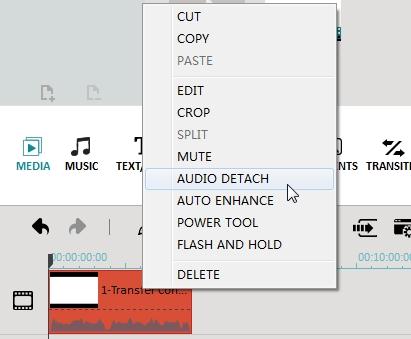
3 Save the new file
After that, press the Create button to save it to a suitable format. The process will take some time depending on the output file length and your computer performance. When extraction is over, find your file in the destination folder and play it using your media player. Of course, you can also directly upload the new file to YouTube or burn to DVD- all your choice!

 Download Mac Version ](https://tools.techidaily.com/wondershare/filmora/download/ )
Download Mac Version ](https://tools.techidaily.com/wondershare/filmora/download/ )
Now just follow the above detailed guide and easily remove audio from AVI or delete the unwanted sound track. Besides removing audio, you can also use Wondershare Filmora (originally Wondershare Video Editor) to split video , merge videos into one, rotate video , trim and crop video , add image to video, make multi screen video and more. Just download this ideal video editing tool and enrich your video life.
Here is a video tutorial:

Shanoon Cox
Shanoon Cox is a writer and a lover of all things video.
Follow @Shanoon Cox
Shanoon Cox
Mar 27, 2024• Proven solutions
Got video with more than one audio track and want to remove the unnecessary one? Or want to extract audio, sound, or background music from home movies, YouTube videos, and any other video file? Well, what you need is an easy-to-use audio remover. This following article will introduce a step-by-step instruction on how to use powerful video editing software- Wondershare Filmora (originally Wondershare Video Editor) . With it, you can extract audio from video files like AVI, MP4, FLV, AVI, ect and save them in different for formats.
 Download Mac Version ](https://tools.techidaily.com/wondershare/filmora/download/ )
Download Mac Version ](https://tools.techidaily.com/wondershare/filmora/download/ )
1 Add the AVI file to the program
To get started using Wondershare Filmora (originally Wondershare Video Editor), download and install the program. Open the AVI you wish to edit in this video editing software. You can either drag and drop the file into the program or click “Import”. Then AVI file will appear in the media item near the preview pane.

2 Remove the audio from AVI file
Then drag the AVI file into the Video Timeline to begin editing. Right click on the file and select “Audio Detach”. The audio will automatically appear on the Audio Timeline. Click on the audio track you wish to delete and press the “Delete” button on your keyboard. Alternately, you could right-click the track and select the “Delete” command.
Tip: If you want to add a new audio file to the video, just drag-n-drop it to the Audio Timeline. Then double click to edit it in the editing panel. You can change the playing speed, volume, pitch, etc. as you like. You can also hit “Record a voiceover” and plug in your microphone to record your own voice and add it to the video.

3 Save the new file
After that, press the Create button to save it to a suitable format. The process will take some time depending on the output file length and your computer performance. When extraction is over, find your file in the destination folder and play it using your media player. Of course, you can also directly upload the new file to YouTube or burn to DVD- all your choice!

 Download Mac Version ](https://tools.techidaily.com/wondershare/filmora/download/ )
Download Mac Version ](https://tools.techidaily.com/wondershare/filmora/download/ )
Now just follow the above detailed guide and easily remove audio from AVI or delete the unwanted sound track. Besides removing audio, you can also use Wondershare Filmora (originally Wondershare Video Editor) to split video , merge videos into one, rotate video , trim and crop video , add image to video, make multi screen video and more. Just download this ideal video editing tool and enrich your video life.
Here is a video tutorial:

Shanoon Cox
Shanoon Cox is a writer and a lover of all things video.
Follow @Shanoon Cox
Shanoon Cox
Mar 27, 2024• Proven solutions
Got video with more than one audio track and want to remove the unnecessary one? Or want to extract audio, sound, or background music from home movies, YouTube videos, and any other video file? Well, what you need is an easy-to-use audio remover. This following article will introduce a step-by-step instruction on how to use powerful video editing software- Wondershare Filmora (originally Wondershare Video Editor) . With it, you can extract audio from video files like AVI, MP4, FLV, AVI, ect and save them in different for formats.
 Download Mac Version ](https://tools.techidaily.com/wondershare/filmora/download/ )
Download Mac Version ](https://tools.techidaily.com/wondershare/filmora/download/ )
1 Add the AVI file to the program
To get started using Wondershare Filmora (originally Wondershare Video Editor), download and install the program. Open the AVI you wish to edit in this video editing software. You can either drag and drop the file into the program or click “Import”. Then AVI file will appear in the media item near the preview pane.

2 Remove the audio from AVI file
Then drag the AVI file into the Video Timeline to begin editing. Right click on the file and select “Audio Detach”. The audio will automatically appear on the Audio Timeline. Click on the audio track you wish to delete and press the “Delete” button on your keyboard. Alternately, you could right-click the track and select the “Delete” command.
Tip: If you want to add a new audio file to the video, just drag-n-drop it to the Audio Timeline. Then double click to edit it in the editing panel. You can change the playing speed, volume, pitch, etc. as you like. You can also hit “Record a voiceover” and plug in your microphone to record your own voice and add it to the video.

3 Save the new file
After that, press the Create button to save it to a suitable format. The process will take some time depending on the output file length and your computer performance. When extraction is over, find your file in the destination folder and play it using your media player. Of course, you can also directly upload the new file to YouTube or burn to DVD- all your choice!

 Download Mac Version ](https://tools.techidaily.com/wondershare/filmora/download/ )
Download Mac Version ](https://tools.techidaily.com/wondershare/filmora/download/ )
Now just follow the above detailed guide and easily remove audio from AVI or delete the unwanted sound track. Besides removing audio, you can also use Wondershare Filmora (originally Wondershare Video Editor) to split video , merge videos into one, rotate video , trim and crop video , add image to video, make multi screen video and more. Just download this ideal video editing tool and enrich your video life.
Here is a video tutorial:

Shanoon Cox
Shanoon Cox is a writer and a lover of all things video.
Follow @Shanoon Cox
Shanoon Cox
Mar 27, 2024• Proven solutions
Got video with more than one audio track and want to remove the unnecessary one? Or want to extract audio, sound, or background music from home movies, YouTube videos, and any other video file? Well, what you need is an easy-to-use audio remover. This following article will introduce a step-by-step instruction on how to use powerful video editing software- Wondershare Filmora (originally Wondershare Video Editor) . With it, you can extract audio from video files like AVI, MP4, FLV, AVI, ect and save them in different for formats.
 Download Mac Version ](https://tools.techidaily.com/wondershare/filmora/download/ )
Download Mac Version ](https://tools.techidaily.com/wondershare/filmora/download/ )
1 Add the AVI file to the program
To get started using Wondershare Filmora (originally Wondershare Video Editor), download and install the program. Open the AVI you wish to edit in this video editing software. You can either drag and drop the file into the program or click “Import”. Then AVI file will appear in the media item near the preview pane.

2 Remove the audio from AVI file
Then drag the AVI file into the Video Timeline to begin editing. Right click on the file and select “Audio Detach”. The audio will automatically appear on the Audio Timeline. Click on the audio track you wish to delete and press the “Delete” button on your keyboard. Alternately, you could right-click the track and select the “Delete” command.
Tip: If you want to add a new audio file to the video, just drag-n-drop it to the Audio Timeline. Then double click to edit it in the editing panel. You can change the playing speed, volume, pitch, etc. as you like. You can also hit “Record a voiceover” and plug in your microphone to record your own voice and add it to the video.

3 Save the new file
After that, press the Create button to save it to a suitable format. The process will take some time depending on the output file length and your computer performance. When extraction is over, find your file in the destination folder and play it using your media player. Of course, you can also directly upload the new file to YouTube or burn to DVD- all your choice!

 Download Mac Version ](https://tools.techidaily.com/wondershare/filmora/download/ )
Download Mac Version ](https://tools.techidaily.com/wondershare/filmora/download/ )
Now just follow the above detailed guide and easily remove audio from AVI or delete the unwanted sound track. Besides removing audio, you can also use Wondershare Filmora (originally Wondershare Video Editor) to split video , merge videos into one, rotate video , trim and crop video , add image to video, make multi screen video and more. Just download this ideal video editing tool and enrich your video life.
Here is a video tutorial:

Shanoon Cox
Shanoon Cox is a writer and a lover of all things video.
Follow @Shanoon Cox
“Rapid Resonance Refinement: Eliminating Static and Hum in Seconds”
It will be challenging to remove static noise from audio since the language is often muddled by ambient noise, such as the dreaded whirring of an air conditioning unit or fans. This can make it challenging to get good audio. It is common practice to eliminate background noise before recording and mixing sound effects or working on other areas of the video’s design.
You are lucky since the Internet allows you to choose a few strategies for removing noise from audio. You may lessen the amount of noise in your video or audio recording by including some background music or by utilizing software that edits audio or video. This article will significantly assist you in searching for a method to remove static sound from audio, so keep that in mind as you read it. Let’s get started!
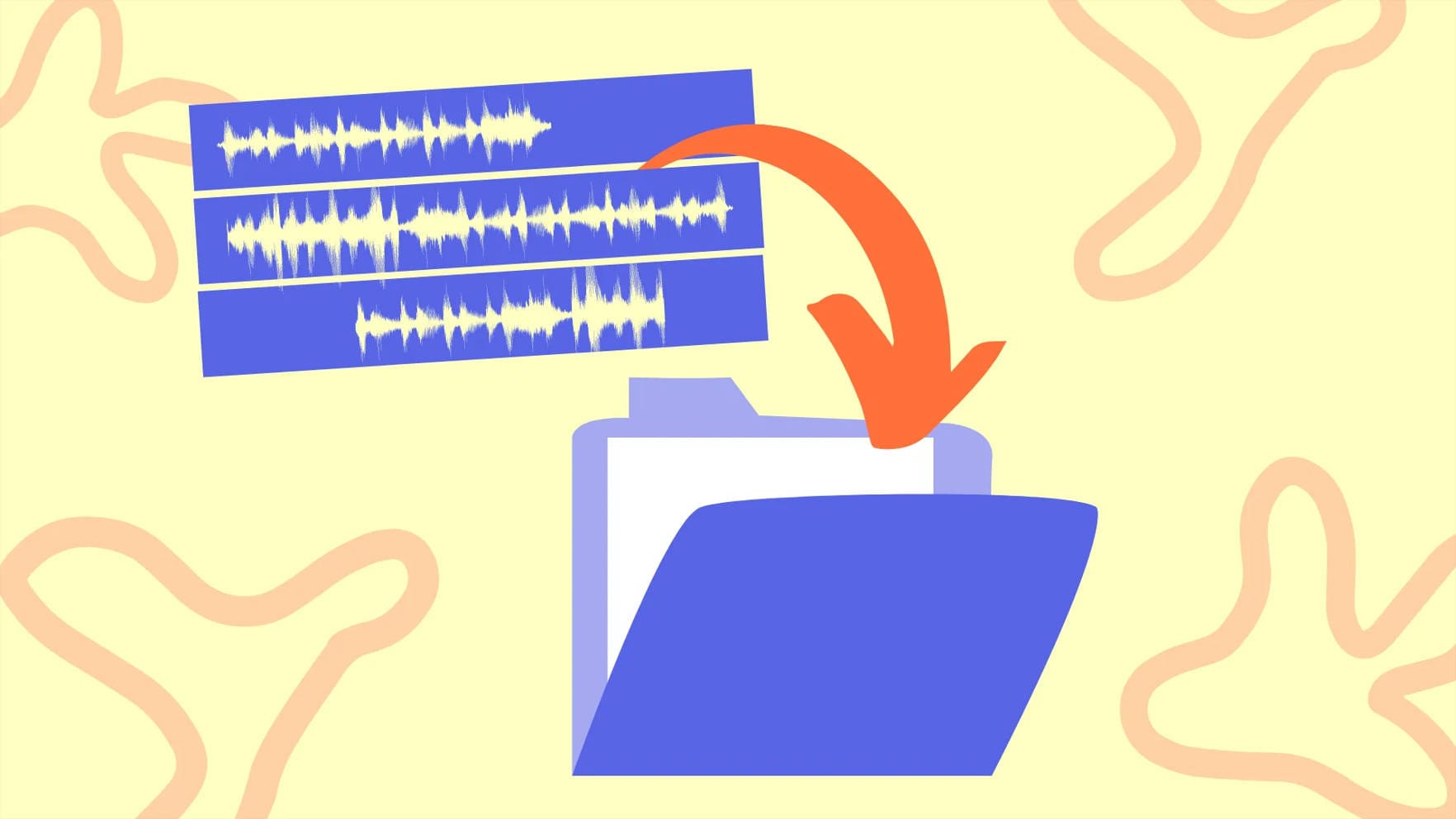
Part 1: How to Remove Static Noise from Audio Files with Only & Free tools?
Consider shaky or unclear video to be a problem. Audio noise may damage your video just as fast as poor visual quality. It may be tricky to remove static sound from audio, however. Additionally, it might be difficult to capture clear audio, particularly in busy areas. There are occasions when you get hissy or otherwise noisy audio, whether because of background noise or less-than-ideal equipment.
1. Audiodenoise
The tool lets you change many things, like the time smoothing of the noise reduction filter, the noise model based on tracking noise modulation, the size of the analysis blocks, etc. So, how do you remove the static audio in the background?
Here are the steps to take.
How to use Audio Denoise to get rid of static noise
Step1 Click on the “Choose File” option to start. You can also choose the video from the list of “Demo files.”
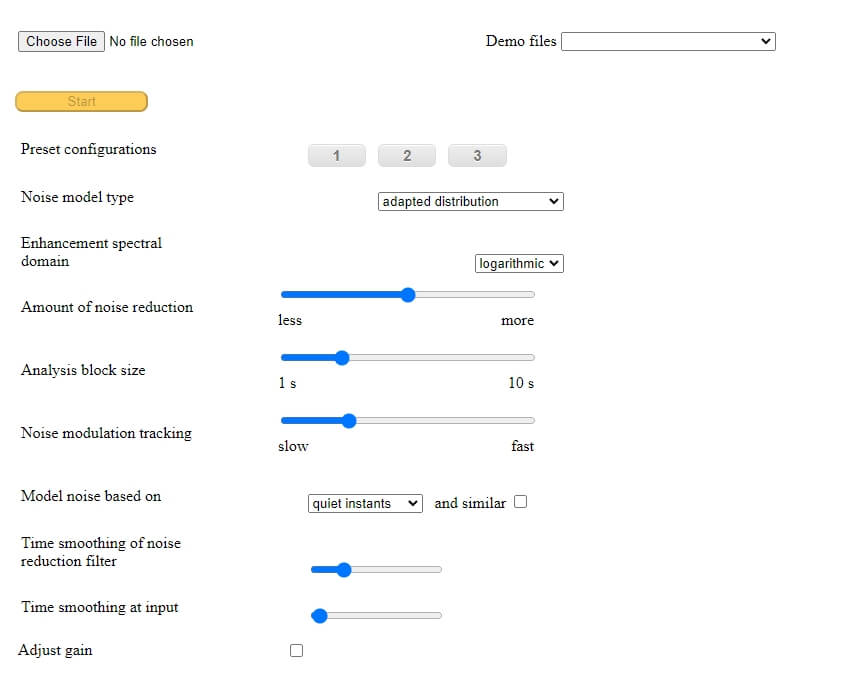
Step2 Press the Process button after you’ve uploaded the file to eliminate the noise in the audio.
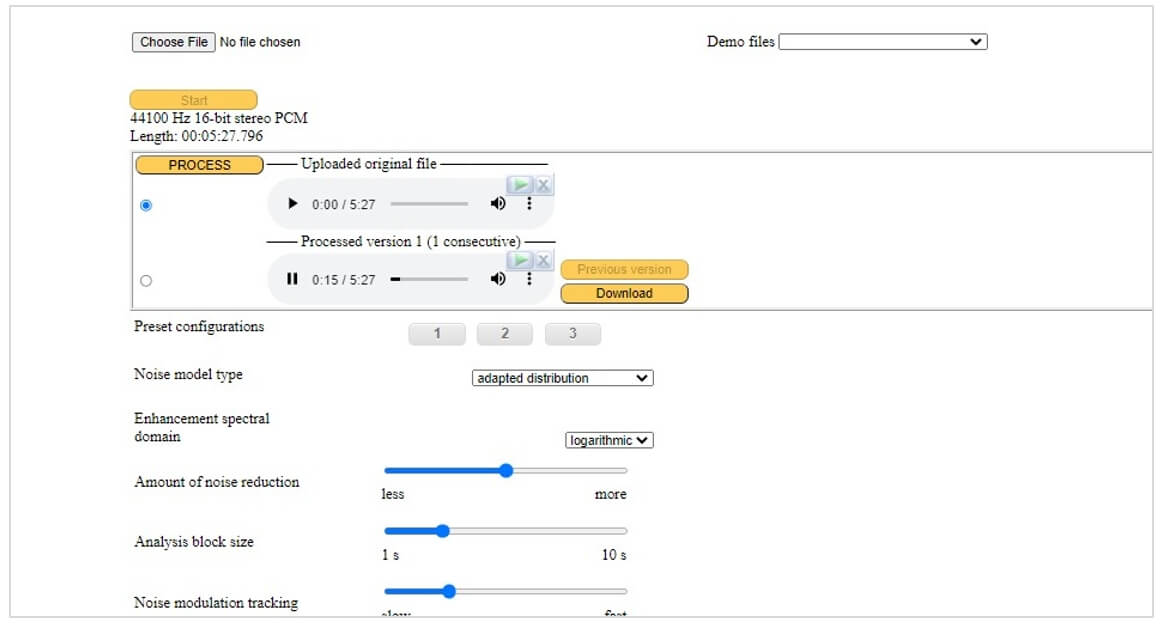
Step3 After the audio is done being processed, click the Download button to save your video to your PC.
2. Wondershare AILab
You may remove static from audio by using Wondershare AILab. There is no need to specify any settings since the AI will identify and eliminate noise on its own automatically. To improve audio quality, use a noise reduction technique based on AI. No more noise will be from the breeze, the crowd, or another unwelcome sound. AILab gives you access to various free online tools that make creating images, sounds, and videos simpler and more enjoyable.
How to use Wondershare AILab to remove static sound from audio
Step1 First, choose or drag your audio file to start uploading it.

Step2 The AI will analyze the file automatically and eliminate the static sound.

Step3 Finally, at this moment, download the revised audio file.
3. Veed.io
With VEED, you can simultaneously record your computer screen and camera, making it simple to produce instructional films for professional or personal use.
VEED is one of the most straightforward online video editors that can remove static from audio with just one click of the mouse, making it an excellent choice for people who are just starting. You don’t need to re-record your audio or purchase expensive microphones that block sound. It can help you eliminate background noise from MP3, WMA, and other audio files, but with a watermark.
How do I remove static sound from the audio file using Veed online?
Step1 To upload your audio file, click the “Choose Audio” button to upload your audio file.

Step2 Click on the audio track to open the Settings menu, then choose “Clean Audio” from the list of options. The background noise will vanish on its own in a few seconds.
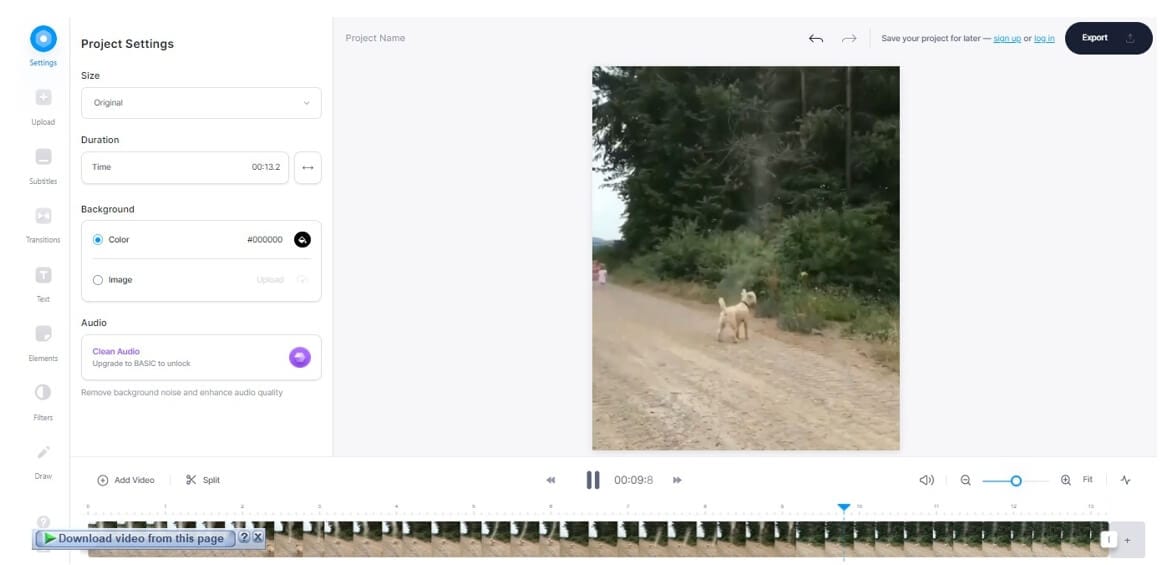
Step3 That’s it; you’re done. When you click “Export,” you will make your new file in a few seconds.
Part 2: How to improve your audio in the best way?
Wondershare is the company that has produced the Filmora family of video production and editing apps. Filmora offers software that may be used by various skill levels, from novice to intermediate. A timeline, a preview window, and an effects library are some of the standard elements of Filmora. These features are accessed and controlled by a drag-and-drop user interface.
Free Download For Win 7 or later(64-bit)
Free Download For macOS 10.14 or later
The Filmora software collection may run on machines running either Windows or macOS operating systems. It is possible to get free product samples to test them out before buying them. On the official Filmora website, you can see pricing choices for each program.
The Filmora Video Editor is easy to use and delivers various features superior to those provided by other video editors. Because of this, it is considered one of the best audio editors to answer how to remove static from audio and video.
Here is how to remove static noise from audio with Filmora.
Step1 Upload Files
Open Wondershare Filmora and load your video into the timeline window. You can get a video preview, cut it up, and remove the bits you don’t want to preserve.
Step2 Edit Audio
Select “Edit Audio” by using the context menu after right-clicking the movie in the timeline. You will see four options: silence detection, modify audio, disconnect audio, and mute. Choose the “Audio” option from the drop-down menu if you want to separate the audio from the video.
Step3 Remove Background Static
Double-click on the audio track to eliminate the background noise directly, and pick “normal denoise” from the Edit Panel. You may also double-click the video clip in the timeline to reach the Editing panel without first separating the audio from the video. Once there, you can edit the audio and eliminate the noise by clicking on the Audio tab in the Editing panel.
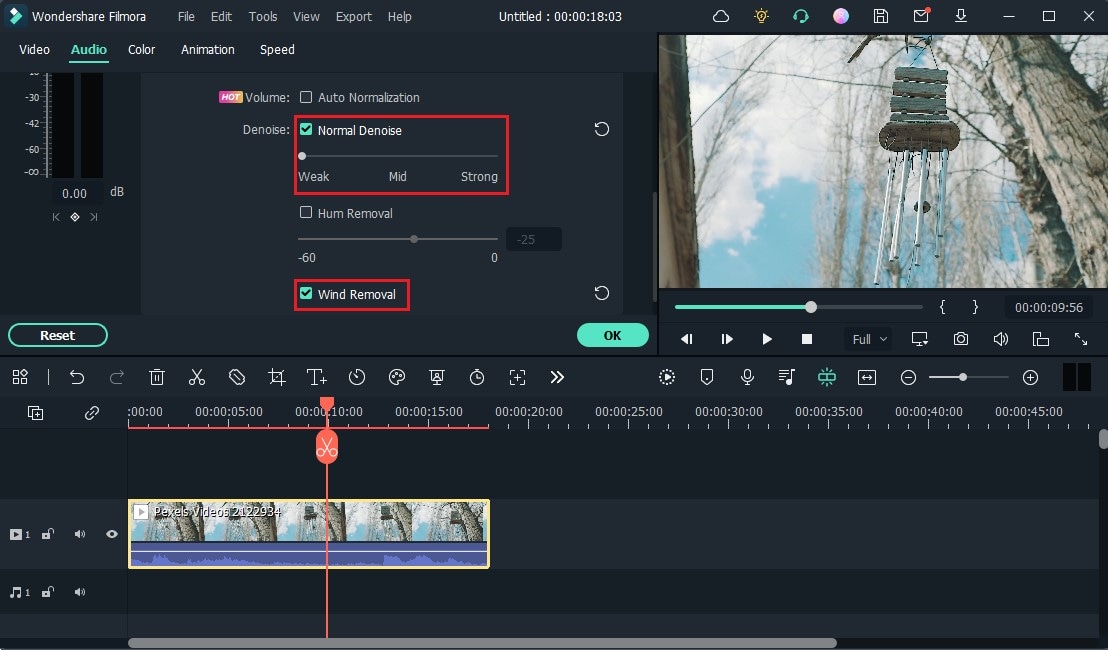
Step4 Fine Tune and Export
Lastly, with Equalizer, fine-tune the sound to make it more natural. For a better effect, adjust the audio frame by frame until it fits perfectly with the video. After the result, you can click “Export” to save the less noisy video on your PC or directly post it to YouTube or Vimeo.
Part 3: How to Record Noise-Free Audio?
So, that was how to remove static sound from audio. But what if you record noise-free audio instead?
If you record with a microphone and continue to hear static noise, the problem most likely lies in the cable. Most microphone cables consist of one or two conductors (wires) braided together inside a metal. This is the function that protection fulfills. It prevents the hum or static created by signals coming from outside from interfering with the signal flowing via the internal conductors.
If one of the shield connections at either end of the wire is only sometimes present or isn’t there, this might produce static electricity. If you can access the connection, check that all cables and shields are connected safely and securely.
Near a stable electromagnetic source is another possible explanation for static, which may be industrial motors or high-power radio transmitters.
Another characteristic of microphones is their impedance. It would be best to use microphone with the same impedance as the recording device.
One last step is to test the static using a different microphone to determine whether the problem persists. If this is the case, the recording device can be the source of the issue.
Conclusion
Do you believe that a grainy or unsteady video is a problem? Video quality is vital, but audio noise can quickly damage your film. However, removing static sound from audio may be a pain in the neck. In addition, capturing clear audio may be challenging, particularly in areas with a lot of background noise.
Now you have an audio file with less or no noise and want to learn how to remove static noise from audio. With the above suggestions, I hope you’ll find eliminating background noise from the video easy. If you want to be more creative in removing static noise from audio, try the Filmora video editor to give your mind a boost.
Free Download For macOS 10.14 or later
The Filmora software collection may run on machines running either Windows or macOS operating systems. It is possible to get free product samples to test them out before buying them. On the official Filmora website, you can see pricing choices for each program.
The Filmora Video Editor is easy to use and delivers various features superior to those provided by other video editors. Because of this, it is considered one of the best audio editors to answer how to remove static from audio and video.
Here is how to remove static noise from audio with Filmora.
Step1 Upload Files
Open Wondershare Filmora and load your video into the timeline window. You can get a video preview, cut it up, and remove the bits you don’t want to preserve.
Step2 Edit Audio
Select “Edit Audio” by using the context menu after right-clicking the movie in the timeline. You will see four options: silence detection, modify audio, disconnect audio, and mute. Choose the “Audio” option from the drop-down menu if you want to separate the audio from the video.
Step3 Remove Background Static
Double-click on the audio track to eliminate the background noise directly, and pick “normal denoise” from the Edit Panel. You may also double-click the video clip in the timeline to reach the Editing panel without first separating the audio from the video. Once there, you can edit the audio and eliminate the noise by clicking on the Audio tab in the Editing panel.

Step4 Fine Tune and Export
Lastly, with Equalizer, fine-tune the sound to make it more natural. For a better effect, adjust the audio frame by frame until it fits perfectly with the video. After the result, you can click “Export” to save the less noisy video on your PC or directly post it to YouTube or Vimeo.
Part 3: How to Record Noise-Free Audio?
So, that was how to remove static sound from audio. But what if you record noise-free audio instead?
If you record with a microphone and continue to hear static noise, the problem most likely lies in the cable. Most microphone cables consist of one or two conductors (wires) braided together inside a metal. This is the function that protection fulfills. It prevents the hum or static created by signals coming from outside from interfering with the signal flowing via the internal conductors.
If one of the shield connections at either end of the wire is only sometimes present or isn’t there, this might produce static electricity. If you can access the connection, check that all cables and shields are connected safely and securely.
Near a stable electromagnetic source is another possible explanation for static, which may be industrial motors or high-power radio transmitters.
Another characteristic of microphones is their impedance. It would be best to use microphone with the same impedance as the recording device.
One last step is to test the static using a different microphone to determine whether the problem persists. If this is the case, the recording device can be the source of the issue.
Conclusion
Do you believe that a grainy or unsteady video is a problem? Video quality is vital, but audio noise can quickly damage your film. However, removing static sound from audio may be a pain in the neck. In addition, capturing clear audio may be challenging, particularly in areas with a lot of background noise.
Now you have an audio file with less or no noise and want to learn how to remove static noise from audio. With the above suggestions, I hope you’ll find eliminating background noise from the video easy. If you want to be more creative in removing static noise from audio, try the Filmora video editor to give your mind a boost.
Also read:
- 2024 Approved The Modern Guide to Implementing Decay in Sound Tracks
- Guidelines for Overcoming 'Call Failed' Error on Win10/11
- In 2024, 7 Fixes to No GPS - Showing Approximate Location on Apple iPhone 12 Pro Waze | Dr.fone
- In 2024, Bringing Your Nikon Videos to Life Essential Editing Skills and Tools
- Mastering Chroma Key Techniques in Live Broadcasts for 2024
- New 2024 Approved Steps for Integrating Soundtracks Into MKV Format (MKV v2.0.2 Release)
- New In 2024, Dissecting Sound Forge An Experts Guide to Audio Mastery
- New In 2024, Steps for Extracting Auditory Elements From MP4 Files
- Prime Day's Hottest Apple Offers: Explore the Top 36 Deals Still on Sale at ZDNET!
- Selecting Video Editors Filmora Vs. Democreator Compared for 2024
- Step-by-Step Fix for Syncing a Samsung Universal Printer with Your Windows Device
- Updated Achieving Superior Sound in MP4 Videos A Comprehensive Guide for 2024
- Updated In 2024, The Ultimate Guide to Preventing Phasing Issues in Studio Monitoring
- Why does the pokemon go battle league not available On Nokia 150 (2023) | Dr.fone
- Windows Nvidia Driver - GTX 1650 Release
- Title: New Top 10 Audio Normalizers for Windows-Dont Miss It
- Author: Kate
- Created at : 2024-10-18 16:42:48
- Updated at : 2024-10-23 17:22:36
- Link: https://audio-editing.techidaily.com/new-top-10-audio-normalizers-for-windows-dont-miss-it/
- License: This work is licensed under CC BY-NC-SA 4.0.